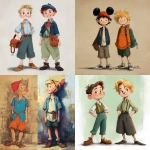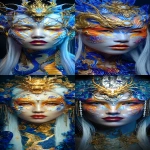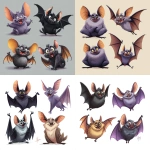Explore the Best AI Image Gallery

Beyond the Canvas: Wearable Tech and the Evolution of Artistic Expression
The intersection of technology and creativity has always been a fertile ground for innovation. From the advent of photography to the rise of digital art, each technological leap has reshaped the way we create and experience art. Today, wearable technology stands poised to revolutionize artistic expression once again, blurring the lines between the physical and digital realms.
Wearable devices, such as smart glasses, haptic suits, and gesture-controlled interfaces, empower artists with unprecedented tools for creation and interaction. They allow for immersive experiences, real-time feedback, and a deeper connection between the artist and their audience.
Innovative Applications of Wearable Tech in Art
- Interactive Installations: Imagine walking through an art installation where your movements trigger light patterns, sound sculptures, or projections that respond to your presence. Wearable sensors can capture real-time data about the viewers actions and translate them into dynamic artistic expressions.
- Augmented Reality (AR) Art: AR overlays digital elements onto the physical world, creating interactive artworks that exist in both realms. Artists can use wearable devices to design AR experiences that enhance traditional paintings, sculptures, or even urban landscapes.
- Performance Art and Choreography: Wearable tech can be integrated into performance art and choreography, allowing dancers to control lights, sound effects, or projected visuals with their movements. This creates a captivating interplay between the physical and digital, pushing the boundaries of artistic expression.
- Gesture-Based Painting and Sculpting: Artists can use wearable gloves or controllers to paint or sculpt in virtual spaces, translating their hand movements into digital strokes or 3D models. This opens up new possibilities for creating art without physical limitations.
Ethical Considerations
As with any emerging technology, wearable tech in art raises important ethical considerations.
- Data Privacy: Wearable devices collect vast amounts of personal data about users movements, preferences, and interactions. It is crucial to ensure that this data is handled responsibly and ethically, with transparent consent mechanisms and safeguards against misuse.
- Accessibility and Inclusivity: Not everyone has equal access to wearable technology or the digital skills needed to use it effectively. Artists and designers must consider accessibility in their creations to ensure that all individuals can participate in and benefit from these experiences.
- The Nature of Authorship: As AI and machine learning become more integrated into artistic processes, questions arise about the nature of authorship and creativity. Who owns the copyright for artwork created with the help of algorithms?
Future Trends
The evolution of wearable tech in art is constantly unfolding, with exciting advancements on the horizon:
- Brain-Computer Interfaces (BCIs): BCIs could allow artists to translate their thoughts and emotions directly into artworks, creating a truly immersive and personal creative experience.
- Personalized Art Experiences: Wearable tech can enable personalized art experiences tailored to individual preferences and responses. Imagine art that adapts in real time to your mood or emotions.
- Collaborative Artistic Creations: Wearable devices can facilitate collaborative art projects, where artists from different locations can contribute to a shared artwork simultaneously.
The fusion of wearable technology and artistic expression is a captivating journey. As these technologies continue to evolve, we can anticipate even more groundbreaking applications that will redefine the boundaries of creativity and empower artists to push the limits of imagination.













](https://images.ai-img.art/thumbnails/150/2fbd98ecfc425cfc1597779121e1c0305437067779e9c471eb64ff9615d5be98.webp)

](https://images.ai-img.art/thumbnails/150/8d1fe5a7a49cfc96747182431a853357913286d89258383caab2d3b4681afcb5.webp)







](https://images.ai-img.art/thumbnails/150/485c8b1c747827bdc9a962f8a1919b3c259b18dd263b260208a1eae19fb85e07.webp)






](https://images.ai-img.art/thumbnails/150/5197af8969d850e2a43e141d41e482ccbceedebceb2a4caf9f098f943f9d1b0f.webp)




](https://images.ai-img.art/thumbnails/150/3020b8c2b6d9be07e042357107af1de10deb274a41d2b0f332684ad4b532a702.webp)



](https://images.ai-img.art/thumbnails/150/269414b0e541026702e9e67c67602c96162f37ff460a388b3b36314c8fc936dd.webp)









